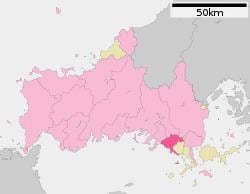Local time Saturday 11:53 PM | Population 53,946 (31 Mar 2012) | |
 | ||
Time zone Japan Standard Time (UTC+9) Website www.city.hikari.yamaguchi.jp Weather 4°C, Wind NE at 6 km/h, 75% Humidity Points of interest Kanmuriyama Park, Fugenji, Ishishiroyama | ||
Hikari (光市, Hikari-shi) is a city located in Yamaguchi Prefecture, Japan.
Contents
Map of Hikari, Yamaguchi Prefecture, Japan
The city was founded three times‹See TfD›: April 1, 1943, July 1, 1955, and October 4, 2004.
As of March 31, 2012, the city has an estimated population of 53,946, with 22,986 households and a population density 586.75 of persons per km². The total area is 91.94 km². The name Hikari itself means "brilliance" or "light" in Japanese.
It is connected by railroad with a train station and route 188.
Hikari is bounded with Yanai, Kudamatsu, Shunan, Iwakuni and Tabuse in the Kumage District.
On October 4, 2004, the town of Yamato (from Kumage District) was merged into Hikari.
Municipal timeline
Military
The Hikari Naval Arsenal (or Dockyard) included a fire-control factory, built in 1942, that employed about 600 people. It was one of the principal establishments for producing the Standard H.A. System (Type 94 Kosha Sochi) at the rate of ~15 per month, along with bomb components, torpedo afterbodies, and misc. machined parts.
The Imperial Japanese Navy formed the Second Special Attack Force (former First Special Base Unit) on March 1, 1945, at Hikari for conducting kaiten attacks. Rear Admiral Nagai Mitsuru was the Commanding Officer. On that same day, a kaiten crew training unit is also formed at Hirao, SE of Hikari. This was one of four such kaiten training bases.
With hints of cessation of hostilities, bombing raids by U.S. forces were canceled. However, resumption of bombing was ordered on August 13, 1945. The Hikari Naval Arsenal was consequently bombed the next day on August 14, 1945 (one day before the end of war), taking 738 lives. The attacking U.S. aircraft were 156 B-29 bombers of the 40th Bomb Group stationed in Saipan, supported by P-51 Mustangs from Iwo Jima. The 40th Bomb Group dropped 3,540 bombs (885 tons) on the Hikari Naval Arsenal, resulting in severe destruction. Including this bombing, Hikari lost more than 1,200 citizens in World War II, both military and civilian. After surrender, Allied forces found 52 kaiten at Hikari and destroyed them.
The former Hikari Naval Arsenal is now the sites for Nippon Steel Corporation and vaccine manufacturing by Takeda Pharmaceutical Company. Takeda discovered the hull of a Type 4 Kaiten under one of the buildings in August 1989, an attestation to the history of the site.
The Kaiten Monument, erected in 1996, honors Hikari Naval Arsenal kaiten pilots. Steel frames that once constituted the structure of the destroyed Hikari Naval Arsenal were used to build the Tsukumo Bridge.
